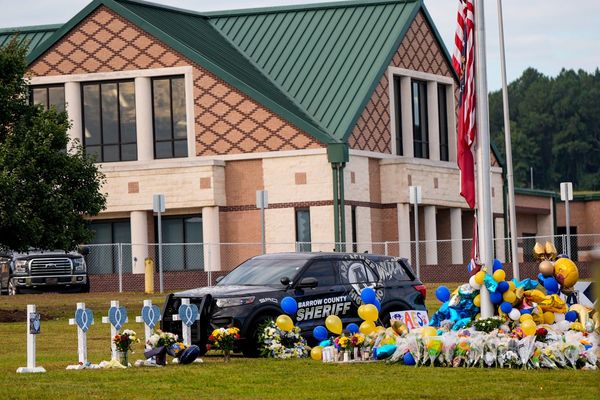SAN DIEGO -- After moving to San Francisco in 2016, artist Claire Starkweather Forrest and family left the city a year later. The home they were staying in with their two young children, while she was pregnant with their third, was being tripled in size to be sold. This had been their fourth rental in the city and they didn't want to have to move their two boys yet again, so they chose to return to San Diego.
"I wondered, 'What happens to a city when families can no longer afford to live there? What will be the long-term impact on a city when the families in the very communities that make the city a great place to raise children, have to leave? What happens to the cultural fabric of the city? What is left?'" she asked herself.
That was the catalyst for her current exhibition, "Where Have All the Children Gone?," inspired in part by a 2017 article from The New York Times with a similar title, documenting the decrease in the number of children in the city and its implications on community and culture. The art show is on display through the end of September at Gallery-by-the-Sea, inside St. James-by-the-Sea Episcopal Church in La Jolla, with an opening reception at 7 p.m. tonight. Her work includes 10 drawings on paper, with two pieces on vinyl records (including a painting).
Forrest, 43, lives with her husband and their three children near Windansea beach in La Jolla. She's worked as an art teacher, art consultant, muralist, and is a full-time fine artist and illustrator. She took some time to talk about her latest work and its focus on the costs of housing, the displacement of families, and the effects that has on culture. (This email interview has been edited for length and clarity. )
Q: How would you describe the style of art you create?
A: I would describe my work as illustrations where whimsy and social issues meet.
Q: How would you describe your point of view as an artist?
A: As an artist I like to explore the various layers of meaning behind seemingly ordinary objects. So, looking at something and asking, "What is the history behind it? What does it stand for? What story does it have to tell?" For example, why do kids love their stuffed animals? They provide security and comfort when things are uncertain or scary. How many stuffed animals have comforted children who have moved out of San Francisco, out of neighborhoods they know, because of the changes occurring in the city?
Q: Your current exhibition, "Where Have All the Children Gone?," was inspired by your reflections on the housing market. Tell us about how you came to focus your art on this topic, and what the name of your exhibit means.
A: In 2017, I read "San Francisco Asks: Where Have All the Children Gone?" in The New York Times and it really resonated with me. Someone had put into words everything we had experienced in our short time as San Franciscans. We moved to San Francisco in 2016 while the housing market was booming, and it became immediately apparent that rising costs were making it difficult for families to call San Francisco home. We had been living there for a few months when the owner of our 110-year-old, 1,200-square-foot home applied for a building permit to take the house down to the studs and triple the square footage. We thought about fighting it since it was the fourth rental we'd lived in and we didn't want to have to move our sons again, so we talked to other families at our son's school. They casually responded with, "Oh yeah, that happened to us, too." One mom was a native to San Francisco and to the land as an Indigenous person and a Latina who grew up in the Mission District. She and her partner could no longer afford to live there and had moved south of the city, so they were commuting to send their son to school, wanting him to at least attend school in the neighborhood if they could no longer afford to live there. He was attending on a scholarship, and she was worried about whether the school would change its mind and ask them to leave.
We decided not to fight the building permit and the house was later sold for $7.6 million. Although we'd been lucky to be able to move to San Francisco in the first place and to afford living there when so many could not, I remember wondering if it was possible for a family to actually live in that city or if it was reserved for the wealthy and single.
Q: Why was housing and its relationship to community and culture something you felt drawn to express through your art?
A: San Francisco was not the city we thought we were moving to. Many of the neighborhoods seemed more like stages with props set up, populated by actors without any ties to the set. You can't re-create the art of culture in a city when the very families who brought it there have left. A city like San Francisco, or any American city, loses an invaluable gift when families are forced to leave. Not only do you lose a quality of life, but you lose history.
Years before we'd moved to San Francisco, we were visiting the city with our oldest son, who was just a year old. He had a beloved lion that he took everywhere, and we were pushing him in his stroller through the heart of the city when he suddenly realized he had dropped his lion. We started to retrace our steps, but his lion was gone. I was inspired by his missing lion and the cultural and economic identity crisis that cities like San Francisco are experiencing at the moment.
Q: What was your creative process for completing the work you have on display?
A: For me, with this series, there were two parts to my creative process. One was the actual execution of the drawings themselves. I worked with photographs, numerous studies and sketches upon sketches. Each completed drawing in this exhibition probably had at least five drafts to get it there.
The other side of my creative process is my research. I have my own personal experiences that I bring to my work, like any artist, but with this series I was constantly reading. There were newspaper articles like Fuller's, as well as "A Changing Mission" from The San Francisco Chronicle, and "American Dream of Owning a Home, Out of Reach For Many in Tight Markets" from The Guardian, to name a few. There were also numerous books of both nonfiction and historical fiction, such as "A Tree Grows in Brooklyn" by Betty Smith, "How the Word is Passed: A Reckoning with the History of Slavery Across America" by Clint Smith, and "The Warmth of Other Suns: The Epic Story of America's Great Migration" by Isabel Wilkerson. Then, there were the podcasts on social issues with Emmanuel Acho, Brené Brown, Aiko Bethea and Clint Smith. I was reading about the history of San Francisco, it's different neighborhoods, and how they were developed: the Mission District, neighborhoods being built on buried boats when they ran out of land to call home, who was allowed to purchase a home and who wasn't and why. I was reading about the history of the land's people — the Muwekma Ohlone people, the missionaries, "paper sons" [a term used to describe immigrants from China using false U.S. citizenship papers as a result of the discriminatory Chinese Exclusion Act of 1882], Italians, etc. Some of my most valued research I gained from the people I met and the stories they shared with me.
Q: How long did it take from idea to completion?
A: I began creating these drawings in 2018 and was set to have an exhibition in 2020, but the world obviously had other plans. I wouldn't say this series is complete. I still feel inspired by the relationship between families, urban lifestyles and culture. I don't think that San Francisco's problem of families leaving the city is a unique one; it's a challenge that many cities throughout the United States and around the world are having. I have really enjoyed working on this series and diving into the research, the people I have met, the stories they have shared with me, and observing the living organism that is life in a city and how it is always changing.
Q: What can people expect to see if they visit "Where Have All The Children Gone?"
A: You can expect to see work that tells a story that is enticing to children and to people of all ages. I hope that my work will be thought provoking and that people will enjoy it. The gallery is open on weekdays by appointment, and from 9 a.m. to 2 p.m. on Saturdays, and noon to 3 p.m. on Sundays. We're having a kids pop-up art market from 9 a.m. to 1 p.m. on Sept. 24. I'm hoping the community will come out and enjoy some local, female-owned, small-business vendors. We are encouraging children to bring their favorite stuffed animal and join me in creating some art in the gallery space. We hope it will be a good event for families and creatives of all ages.
Q: What do you hope people understand about this topic as a result of visiting and viewing the art you've created here?
A: The paradox inherent in many American cities: the very things that make them attractive places to raise children, their history, their culture and their vibrancy are products of families who can no longer afford to live there.
____







